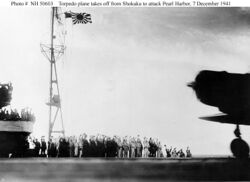Pearl Harbor (World War II): Difference between revisions
imported>Howard C. Berkowitz |
imported>Howard C. Berkowitz |
||
| Line 21: | Line 21: | ||
==The attack== | ==The attack== | ||
===Preliminaries=== | ===Preliminaries=== | ||
[[Image:Japanese Kate in Pearl Harbor attack.jpg|thumb|250px|Japanese torpedo bomber taking off to attack | [[Image:Japanese Kate in Pearl Harbor attack.jpg|thumb|250px|Japanese torpedo bomber taking off to attack Pearl Harbor]] | ||
===First wave air attack=== | ===First wave air attack=== | ||
Revision as of 20:48, 25 August 2010
For the geographic area, see Pearl Harbor
On December 7, 1941, units of the Imperial Japanese Navy conducted air and submarine operations against American forces in the Battle of Pearl Harbor. This battle was a key element in the major Japanese escalation of what they call the Pacific War.
While the United States had intelligence suggesting a high probability of Japanese attacks in December 1941, and some specific information that either did not reach the Pearl Harbor commanders, Admiral Husband Kimmel (Navy) or Lieutenant General Walter Short (Army), the attack was a tactical surprise.
Few battles, and the circumstances leading to them, have been studied as extensively as this one. Many concepts of the discipline of intelligence and warning resulted from this action.
Japanese operational concept
U.S. intelligence and planning
Communications intelligence
Threat assessment
Sabotage vs. air attack
Short was convinced that the major threat to his aircraft was sabotage by residents of Japanese ancestry, so he had them parked in close formation for ease in guarding them against ground attack. This made them dense targets for strafing and bombing.
Implications of the Battle of Taranto
In 1940, the Royal Navy, at the Battle of Taranto, delivered a devastating night attack, by torpedo aircraft, to battleships in a harbor. The U.S. Navy, in spite of knowing the details of that attack, still believed its ships were safe from aerial torpedoes in a harbor, although Taranto was as shallow as Pearl.
